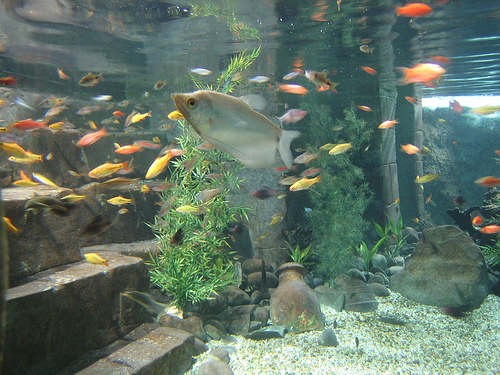Moonlight Gourami (Trichogaster microlepis) - Wiki Moonlight gourami
From Wikipedia, the free encyclopedia
[Photo] Trichogaster microlepis (Moonlight gourami). From http://en.wikipedia.org/wiki/Image:TrichogastermicrolepisMoonlightgourami_Commons.jpg
Moonlight gourami (Trichogaster microlepis) is a labyrinth fish of the family Osphronemidae. It may also be called the moonbeam gourami. This peaceful, attractive species is a popular aquarium fish.
Distribution and habitat
The moonlight gourami is native to the Mekong River in Cambodia and Vietnam and Chao Phraya basins. This species has been introduced into the Mekong basin in Thailand. It has also been introduced into Colombia due to escaping from from aquarium rearing facilities.
This species is found in ponds and swamps. It occurs in shallow, sluggish, or standing water habitats with a lot of aquatic vegetation. It is also common in the floodplain of the lower Mekong.
Appearance and anatomy
An adult moonlight gourami reaches a length of to up 13 centimetres (5 in) SL.
These fish are silvery colored with a slightly greenish hue similar to the soft glow of moonlight. The moonlight gourami’s concavely sloped head distinguishes it from other gourami varieties. The males can be identified by the orange to red coloration of the pelvic fins, as well as the long dorsal fins which ends in a point. In females, the pelvic fins are colorless to yellow, and the dorsal fins are shorter and rounder. During spawning, in males, the orange thread-like ventral fins will intensify and become red.
Ecology
The moonlight gourami eats insects, crustaceans, and zooplankton.
Like all labyrinth fish, the moonlight gourami has a special lung-like organ that allows it to breathe air directly. Because of this labyrinth organ, it is not unusual to see it go to the surface and gulp air. The ability to breathe air allows the Moonlight Gourami to survive in very low oxygen situations. In fact, if it remains moist it can actually survive out of water for up to several hours.
As with other labyrinth fish, these species are oviparous and employ bubble nests in reproduction and care of fry. The male moonlight gourami begins the spawning process by carefully preparing a bubble nest; this bubble nest tends not to incorporate much plant matter and the bubbles may float around freely. It will then begin to court the female under it by performing a "courtship dance" behavior. Spawning culminates when the male finally wraps itself around the female. While in this embrace, the male turns the female on to her back triggering the female to release her eggs. Up to 2000 eggs may be laid during spawning. The male will fertilize the eggs as they float up to the prepared bubble nest. In the safety of the bubble nest the eggs will incubate for about two to three days before finally hatching.
In the aquarium
Although undemanding about water conditions and requires only intermediate care, it thrives best in soft acidic water. Because it is so tolerant of less than perfect water, it is often recommended for a beginner in the fishkeeping hobby. However, as in most other fishes, regular water change will help maintain the health of the moonlight gourami. Ideal pH level for the gourami is 6.0???7.0 with the water hardness at 2???25 dGH and the temperature kept between 26???20°C (79???86°F).
It thrives in a heavily planted aquarium. Preferable vegetation are the sturdy Java fern and Vallisneria. The moonlight gourami are social and peaceful fish that are suitable for community tanks. However, large specimens, particularly males, may attack others of the same or closely-related species. On the other hand, the moonlight gourami could be a shy and timid fish that regularly hides behind vegetation and gets bullied by more aggressive tank mates. The moonlight gourami is also a top or middle tank-level dweller. Minimum tank size requirement is 20 gallons.
The moonlight gourami will accept flakes, frozen and live foods. However, in the case of community tanks, other large, fast fish can scare the moonlight gourami away from food as the timid gourami does not compete well for its meal even if starving.
Breeding
Breeding of this fish is easy. The moonlight gourami should be provided with a separate breeding tank because other fish consider eggs and small babies (fry) as food. An ideal breeding tank has very soft water that has been reduced to a depth of about six inches; floating plants can also be present to give the fish a feeling of security. The pH should be slightly acidic and the temperature should be raised to at least 80°F over a period of several days to trigger spawning. Dark gravel, plenty of floating plants to assist in bubble nest building, as well as feeding of live foods to the breeding pair will increase the chances for successful reproduction. After spawning, the aquarists often provide the female a thicket of fine-leaved plants to hide if the male becomes aggressive; however, the moonlight gourami will not harm the female as other species of labyrinth fish might.
Once the eggs hatch, the fry must be fed very fine foods several times daily. The fry are tiny and delicate for the first few weeks of their lives. Most losses of fry are due to the lack of adequate food or low water temperature. Live foods such as daphnia, artemia and rotifers are ideal. However, very finely chopped lettuce, banana skins, and finely ground flake food can also be used to feed the young. The water temperature in the low to middle 80 degrees Fahrenheit are ideal while the fry are growing.
http://en.wikipedia.org/wiki/Moonlight_gourami
| The text in this page is based on the copyrighted Wikipedia article shown in above URL. It is used under the GNU Free Documentation License. You may redistribute it, verbatim or modified, providing that you comply with the terms of the GFDL. |
